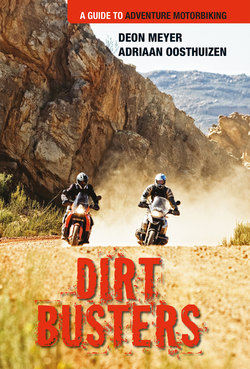Читать книгу Dirt Busters - Деон Мейер - Страница 9
ОглавлениеOur grading system
We have ridden all the routes in this book ourselves. Some fairly recently, others a few years ago. The photos accompanying each route description in this book were also taken on that particular route.
These are by no means the only dirt roads worth exploring in South Africa. (On a recent tour of the Eastern Cape we realised once again how many incredible roads there are to discover.) These are also not the only ones we explored, but they are definitely our favourites.
The trouble with untarred routes, of course, is that traffic and the elements can change a tame gravel, dirt or farm road into a monster overnight. Even normal use – and lack of maintenance – can result in serious changes in the degree of difficulty over a few months or years. On the other hand, sometimes an adventurous rough-and-ready route might have been repaired since we last rode it – you might find a highway where we had a wild ride before.
In the former GS Challenge Jan du Toit and I (you will hear a lot about Jan in this book) had the wonderful experience of developing routes for our participants. And one of the great lessons we learned was that, despite our best efforts in indicating the difficulty level of routes, we were never entirely successful. Riders’ skills – and their perceptions of them – differ.
Even when we demarcate a road as a ‘1’ – easy, in excellent condition – there are always sneaky, hidden turns and hills, local traffic, and farm and wild animals to catch you out.
Another dilemma is that some of the routes include servitudes that are often controlled by farmers. Seasonal livestock moves, outbreaks of animal diseases, theft, or misuse of the through-routes sometimes cause farmers to lock the gates. As a result we can’t guarantee the condition of, or access to, all the routes.
So the grading system we offer for each route is merely a guideline. We hope you will use common sense for the rest.
Route grading
1 Excellent, easy gravel road, with a predictable, even surface, and little evidence of a sandy central ridge (or ‘middelmannetjie’).
2 Gravel road with the occasional spot where you have to be careful – expect an aardvark hole or two, central ridge in the road, hardened mud tracks or potholes.
3 A farm road presenting a technical challenge. Here and there you’ll come across a gully, drift, serious pothole, sandy spot or deep ruts.
4 A track requiring much skill: steep, stony up- or downhills, long stretches of loose sand, difficult water crossings, large stones, loose stones, unexpected ditches or dongas.
5 An adrenaline-charged route for the exceptionally skilful with impossible gradients, unexpected, hidden and very dangerous rocks, stones, sand, mud and water. You could injure yourself seriously if you don’t know exactly what you are doing. Never attempt such a route alone; preferably in groups of three or more very experienced riders.
GPS, maps and software
Electronic navigation has experienced one revolution after the other over the last decade – to the benefit of road users everywhere. Cellphones with GPS and map software are gaining ground at an astonishing rate, while GPS manufacturers are multiplying daily.
The disadvantage is of course the Babel-like confusion of standards, platforms and programming, complicating the electronic availability of the mapping of our routes.
We use Garmin products – and their MapSource program. All our routes are compiled and tested with Garmap’s SA Topo maps (specifically Garmap SA Topo 2011 – which is in our opinion their most accurate work to date), and we recommend this software for anyone who is serious about adventure motorbikes. It is based on the 1:50 000 topographical chart of Southern Africa, and does automatic routing, even for obscure farm roads.
You can download all of this at www.deonmeyer.com/bike/bike.html.
Lastly, the kilometre markers are based on the distance from the starting point, which is provided with each route description.
